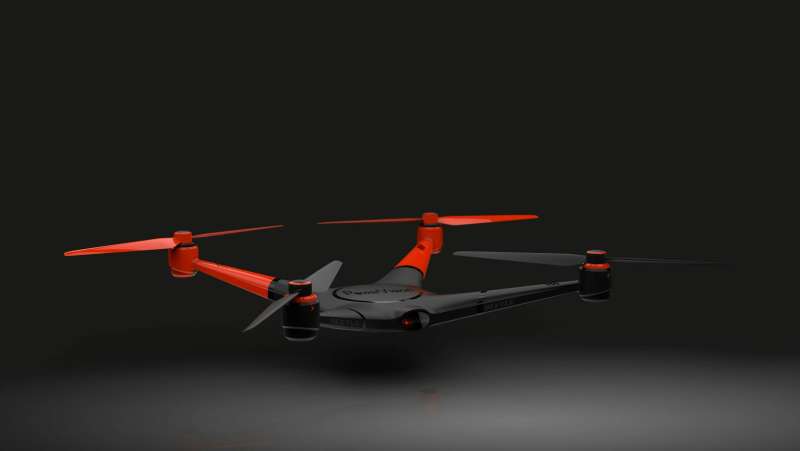Autonomous Drones: Revolutionizing Logistics and Deliveries
Published on: May 9, 2025
The Rise of Autonomous Drones in Logistics
Over the past decade, the logistics and delivery industries have undergone a dramatic transformation, largely due to advances in autonomous drone technology. These unmanned aerial vehicles (UAVs) are equipped with sophisticated navigation systems, artificial intelligence, and sensors that allow them to operate independently, without the need for direct human control. The integration of drones into logistics chains has enabled faster, more efficient, and more reliable delivery of goods, especially in areas where traditional transportation methods face significant challenges. The global market for autonomous drones is rapidly expanding, with industry leaders and startups alike investing heavily in research and development to unlock new possibilities for automated delivery systems.
Autonomous drones are designed to carry out complex tasks with minimal human intervention. Through the use of GPS, computer vision, and real-time data processing, these drones can navigate urban environments, avoid obstacles, and deliver packages to precise locations. This capability is particularly valuable for last-mile delivery, where conventional vehicles often encounter traffic congestion, limited access, and high operational costs. By taking to the skies, drones bypass many of these hurdles, reducing delivery times and improving overall efficiency.
Technological Foundations of Autonomous Drones
The core technology behind autonomous drones combines several cutting-edge fields, including robotics, artificial intelligence, machine learning, and sensor fusion. Modern drones are equipped with high-resolution cameras, LiDAR sensors, radar, and ultrasonic devices that enable them to perceive their surroundings in three dimensions. These sensors feed data into onboard computers, which use advanced algorithms to interpret the environment, identify obstacles, and plan optimal flight paths in real time.
Artificial intelligence plays a crucial role in the autonomy of drones. Through deep learning and neural networks, drones can recognize objects, classify terrain, and even anticipate changes in weather conditions. This allows them to make split-second decisions, such as rerouting to avoid a sudden obstacle or adjusting altitude to compensate for wind gusts. The integration of edge computing further enhances these capabilities, enabling drones to process vast amounts of data locally, without relying on remote servers or constant connectivity.
Another key component is the development of reliable communication systems. Autonomous drones often operate as part of larger fleets, coordinated by central management platforms. These platforms use wireless networks, such as 4G, 5G, or dedicated radio frequencies, to monitor drone status, assign tasks, and ensure safe flight operations. Redundant systems and fail-safes are implemented to maintain control and prevent accidents in the event of signal loss or hardware failure.
Applications in Medical Supply Delivery
One of the most impactful uses of autonomous drones is in the delivery of medical supplies. In remote or disaster-stricken areas, traditional transportation methods may be hindered by damaged infrastructure, blocked roads, or long distances. Drones can overcome these barriers by flying directly to their destinations, delivering critical items such as blood, vaccines, pharmaceuticals, and diagnostic samples.
Several high-profile projects have demonstrated the life-saving potential of medical drone deliveries. For example, in Rwanda and Ghana, autonomous drones operated by Zipline have delivered thousands of units of blood and essential medicines to rural clinics, significantly reducing delivery times from hours to minutes. These operations are conducted with high levels of safety and reliability, using pre-programmed flight paths and real-time tracking to ensure timely and accurate deliveries.
During the COVID-19 pandemic, drones played a vital role in transporting test samples, personal protective equipment (PPE), and vaccines to hard-to-reach communities. Their ability to minimize human contact also helped reduce the risk of virus transmission. In addition to emergency response, autonomous drones are being integrated into routine healthcare logistics, supporting regular supply runs to remote health facilities and enabling faster response to medical emergencies.
Food and Essential Goods Delivery
The use of autonomous drones for delivering food and essential goods is rapidly gaining traction, especially in urban environments where congestion and delivery delays are common. Companies like Amazon, Google Wing, and UPS Flight Forward have launched pilot programs to test drone-based delivery systems for groceries, meals, and household items. These services aim to provide customers with rapid, contactless delivery, often within 30 minutes of placing an order.
Drones equipped with secure cargo holds and temperature-controlled compartments can transport perishable goods, ensuring freshness upon arrival. This is particularly valuable for the delivery of medicines, vaccines, and temperature-sensitive foods. The flexibility of drone delivery networks allows for dynamic routing, enabling drones to prioritize urgent deliveries or adjust routes based on real-time traffic and weather data.
In rural and isolated regions, drones provide a lifeline for communities that lack regular access to essential supplies. By bypassing challenging terrain, drones can deliver goods to mountain villages, islands, and disaster zones, where conventional vehicles may be unable to operate. This capability has proven invaluable during natural disasters, such as floods and earthquakes, when roads are impassable and immediate assistance is needed.
Infrastructure Inspection and Maintenance
Beyond logistics and delivery, autonomous drones are increasingly used for the inspection and maintenance of critical infrastructure. Bridges, power lines, pipelines, and telecommunications towers require regular inspection to ensure safety and reliability. Traditionally, these tasks involved manual labor, often in hazardous or hard-to-reach locations. Drones equipped with high-resolution cameras and specialized sensors can perform detailed inspections from the air, capturing images and data that can be analyzed for signs of wear, corrosion, or damage.
Autonomous flight capabilities allow drones to follow precise inspection routes, repeat missions at regular intervals, and automatically adjust their position for optimal data collection. The use of drones reduces the need for workers to climb structures or operate in dangerous environments, improving safety and efficiency. In addition, the data collected by drones can be processed using artificial intelligence to detect anomalies and predict maintenance needs, enabling proactive repairs and reducing the risk of costly failures.
Utilities and infrastructure companies around the world are adopting drone-based inspection systems to monitor assets over vast areas. For example, energy providers use drones to inspect transmission lines in remote regions, identify vegetation encroachment, and assess storm damage. Similarly, transportation agencies deploy drones to survey bridges and highways, streamlining maintenance operations and minimizing disruptions to traffic.
Environmental Monitoring and Conservation
Autonomous drones are proving invaluable tools for environmental monitoring and conservation efforts. Their ability to cover large areas quickly and access difficult terrain makes them ideal for tracking wildlife, monitoring deforestation, and assessing the health of ecosystems. Drones equipped with multispectral and thermal cameras can capture detailed images of vegetation, water bodies, and animal populations, providing researchers with critical data for conservation planning and management.
In agriculture, drones are used to monitor crop health, detect pests and diseases, and optimize irrigation. By analyzing aerial imagery, farmers can make data-driven decisions to improve yields and reduce environmental impact. Drones also play a role in disaster response, mapping areas affected by floods, fires, or hurricanes to guide relief efforts and assess environmental damage.
Conservation organizations deploy autonomous drones to combat illegal activities such as poaching and logging. By patrolling protected areas and using real-time video feeds, drones can detect unauthorized activities and alert authorities, increasing the effectiveness of enforcement and reducing harm to endangered species and habitats.
Challenges and Limitations
Despite their many advantages, the widespread adoption of autonomous drones in logistics and other sectors faces several challenges. Regulatory frameworks governing drone operations vary widely between countries and regions, with restrictions on flight altitude, airspace access, and payload size. Obtaining the necessary permits and certifications can be a complex and time-consuming process, particularly for beyond-visual-line-of-sight (BVLOS) operations, which are essential for long-range deliveries.
Safety and reliability remain paramount concerns. Drones must be able to detect and avoid obstacles, operate in adverse weather conditions, and respond to unexpected events such as equipment failures or interference. Robust testing, redundancy, and fail-safe mechanisms are critical to ensuring safe operations, especially in densely populated or sensitive areas.
Privacy and security are also important considerations. The use of drones equipped with cameras and sensors raises concerns about surveillance and data protection. Ensuring that drone operations comply with privacy laws and ethical standards is essential to maintaining public trust and acceptance.
Technical limitations, such as battery life and payload capacity, continue to constrain the range and types of deliveries that drones can perform. Advances in battery technology, lightweight materials, and energy-efficient propulsion systems are needed to extend flight times and increase carrying capacity. In addition, the integration of drones into existing logistics networks requires investment in infrastructure, such as charging stations, landing pads, and centralized management platforms.
Future Prospects and Emerging Trends
The future of autonomous drones in logistics and delivery is marked by rapid innovation and expanding opportunities. Advances in artificial intelligence, sensor technology, and communication networks are paving the way for more capable and versatile drones. The development of swarm technology, where multiple drones operate collaboratively, has the potential to further increase efficiency and scalability in delivery networks.
Urban air mobility (UAM) is an emerging concept that envisions the integration of drones and other aerial vehicles into city transportation systems. This includes not only package delivery but also passenger transport, emergency response, and infrastructure services. Cities around the world are exploring the potential of UAM to reduce congestion, improve connectivity, and support sustainable urban development.
Regulatory bodies are working to develop standardized frameworks that balance innovation with safety and privacy concerns. Initiatives such as the European Union’s U-space and the United States’ Unmanned Aircraft System Traffic Management (UTM) are designed to facilitate the safe integration of drones into national airspace, enabling more complex and widespread operations.
Collaboration between industry, government, and academia is driving research into new applications and business models for autonomous drones. Startups and established companies are experimenting with droneports, automated warehouses, and hybrid delivery systems that combine ground and aerial vehicles. The growing availability of open-source software and hardware platforms is democratizing access to drone technology, fostering innovation and entrepreneurship.
As the technology matures, autonomous drones are expected to play an increasingly important role in global supply chains, healthcare delivery, infrastructure maintenance, and environmental stewardship. Their ability to operate efficiently, access remote locations, and adapt to changing conditions positions them as a transformative force in the logistics and delivery landscape.
While challenges remain, the continued evolution of autonomous drones promises to unlock new possibilities for faster, safer, and more sustainable movement of goods and services, reshaping the way we think about transportation and connectivity in the 21st century.










